Novel Dual Beam Cascaded Schemes for 346 GHz Harmonic-Enhanced TWTs
Abstract
:1. Introduction
2. HHTWT
2.1. Operating Principle of HHTWT
2.2. SWS Design Methodology of HHTWT
2.2.1. SWS Design
2.2.2. The SWS Length Determination
2.3. The Simulation Results
3. Cascaded Enhanced HHTWT
3.1. Operating Principle of CE-HHTWT
3.2. SWS Design Methodology of CE-HHTWT
3.3. The Simulation Results
4. Pre-Amplified HHTWT
4.1. Operating Principle of PA-HHTWT
4.2. SWS Design Methodology of PA-HHTWT
4.3. The Simulation Results
5. Conclusions
Author Contributions
Funding
Conflicts of Interest
References
- Booske, J. Vacuum electronic sources for high power terahertz-regime radiation. In Proceedings of the 2011 IEEE International Vacuum Electronics Conference (IVEC), Bangalore, India, 21–24 February 2011; p. 11. [Google Scholar] [CrossRef]
- Bates, D.J.; Ginzton, E.L. A traveling-wave frequency multiplier. Proc. IRE 1957, 45, 938–944. [Google Scholar] [CrossRef]
- Liu, S.; Zhong, R. Recent development of terahertz science and its applications. J. Univ. Electron. Sci. Technol. China 2009, 38, 481–486. [Google Scholar]
- Wang, W. Microwave Engineering Technology, 2nd ed.; National Defense Industry Press: Beijing, China, 2009. [Google Scholar]
- Karetnikova, T.A.; Ryskin, N.M.; Belov, K.V.; Ploskih, A.E. Simulation of a 0.2 thz second-harmonic multiplier with sheet electron beam. In Proceedings of the 2017 10th UK-Europe-China Workshop on Millimetre Waves and Terahertz Technologies (UCMMT), Liverpool, UK, 11–13 September 2017; pp. 1–2. [Google Scholar] [CrossRef]
- Gong, H.; Travish, G.; Xu, J.; Wei, Y.; Feng, J.; Gong, Y. High-power tunable terahertz radiation by high-order harmonic generation. IEEE Trans. Electron Devices 2013, 60, 482–486. [Google Scholar] [CrossRef]
- Zhang, C. Research on High-Power Millimeter-Wave Folded Waveguide Traveling Wave Tube. Ph.D. Thesis, University of Electronic Science and Technology of China, Chengdu, China, 2011. [Google Scholar]
- Stuart, R.A.; Wright, C.C.; Al-shamma’a, A.I. Compact tuneable terahertz source. In Proceedings of the 2006 European Microwave Conference, Manchester, UK, 10–15 September 2006; pp. 322–324. [Google Scholar] [CrossRef]
- Nguyen, K.; Ludeking, L.; Pasour, J.; Pershing, D.; Wright, E.; Abe, D.K.; Levush, B. Design of a high-gain wideband high-power 220-GHz multiple-beam serpentine TWT. In Proceedings of the 2010 IEEE International Vacuum Electronics Conference, Monterey, CA, USA, 18–20 May 2010; pp. 23–24. [Google Scholar] [CrossRef]
- Galdetskiy, A.V.; Golenitskiy, I.I.; Myakinkov, V.U.; Negirev, A.A.; Rudy, U.B. On power consumption reduction in 700 GHz BWO. In Proceedings of the 2011 IEEE International Vacuum Electronics Conference, Bangalore, India, 21–24 February 2011; pp. 57–58. [Google Scholar] [CrossRef]
- Paoloni, C.; Mineo, M.; Di Carlo, A.; Durand, A.J.; Krozer, V.; Kotiranta, M. 1-thz cascade backward wave amplifier. In Proceedings of the IVEC 2012, Monterey, CA, USA, 24–26 April 2012; pp. 237–238. [Google Scholar] [CrossRef]
- Tucek, J.C.; Basten, M.A.; Gallagher, D.A.; Kreischer, K.E.; Lai, R.; Radisic, V.; Leong, K.; Mihailovich, R.A. 100 mw, 0.670 thz power module. In Proceedings of the IVEC 2012, Monterey, CA, USA, 24–26 April 2012; pp. 31–32. [Google Scholar] [CrossRef]
- Tucek, J.C.; Basten, M.A.; Gallagher, D.A.; Kreischer, K.E. 0.850 thz vacuum electronic power amplifier. In Proceedings of the IEEE International Vacuum Electronics Conference, Monterey, CA, USA, 22–24 April 2014; pp. 153–154. [Google Scholar] [CrossRef]
- Tucek, J.C.; Basten, M.A.; Gallagher, D.A.; Kreischer, K.E. Operation of a compact 1.03 thz power amplifier. In Proceedings of the IEEE International Vacuum Electronics Conference (IVEC), Monterey, CA, USA, 19–21 April 2016; pp. 1–2. [Google Scholar] [CrossRef]
- Armstrong, C.M.; Kowalczyk, R.; Zubyk, A.; Berg, K.; Meadows, C.; Chan, D.; Schoemehl, T.; Duggal, R.; Hinch, N.; True, R.B.; et al. A Compact Extremely High Frequency MPM Power Amplifier. IEEE Trans. Electron Devices 2018, 65, 2183–2188. [Google Scholar] [CrossRef]
- Pan, P.; Tang, Y.; Bian, X.; Zhang, L.; Lu, Q.; Li, Y.; Feng, Y.; Feng, J. A G-Band Traveling Wave Tube With 20 W Continuous Wave Output Power. IEEE Electron Device Lett. 2020, 41, 1833–1836. [Google Scholar] [CrossRef]
- Lee, K.C.; Domier, C.W.; Johnson, M.; Luhmann, N.C.; Park, H. FIR laser tangential interferometry/polarimetry on NSTX. IEEE Trans. Plasma Sci. 2004, 32, 1721–1726. [Google Scholar] [CrossRef]
- Paoloni, C.; Gamzina, D.; Himes, L.; Popovic, B.; Barchfeld, R.; Yue, L.; Zheng, Y.; Tang, X.; Tang, Y.; Pan, P.; et al. THz Backward-Wave Oscillators for Plasma Diagnostic in Nuclear Fusion. IEEE Trans. Plasma Sci. 2016, 44, 369–376. [Google Scholar] [CrossRef] [Green Version]
- Feng, J.; Tang, Y.; Gamzina, D.; Li, X.; Popovic, B.; Gonzalez, M.; Himes, L.; Barchfeld, R.; Li, H.; Pan, P.; et al. Fabrication of a 0.346-THz BWO for Plasma Diagnostics. IEEE Trans. Electron Devices 2018, 65, 2156–2163. [Google Scholar] [CrossRef]
- Krupnov, A.F. Phase Lock-In of MM/SUBMM Backward Wave Oscillators: Development, Evolution, and Applications. Int. J. Infrared Millim. Waves 2001, 22, 1–18. [Google Scholar] [CrossRef]
- Gong, H.; Wang, Q.; Deng, D.; Dong, Y.; Xu, J.; Tang, T.; Su, X.; Wang, Z.; Gong, Y.; Travish, G. Third-harmonic traveling-wave tube multiplier-amplifier. IEEE Trans. Electron Devices 2018, 65, 2189–2194. [Google Scholar] [CrossRef]
- Gamzina, D.; Li, H.; Himes, L.; Barchfeld, R.; Popovic, B.; Pan, P.; Letizia, R.; Mineo, M.; Feng, J.; Paoloni, C.; et al. Nanoscale Surface Roughness Effects on THz Vacuum Electron Device Performance. IEEE Trans. Nanotechnol. 2016, 15, 85–93. [Google Scholar] [CrossRef] [Green Version]
- Pan, P.; Li, H.; Feng, J. Study on loss of folded waveguide structures of 220 GHz and 340 GHz. In Proceedings of the 2016 IEEE International Vacuum Electronics Conference (IVEC), Monterey, CA, USA, 19–21 April 2016; pp. 1–2. [Google Scholar] [CrossRef]
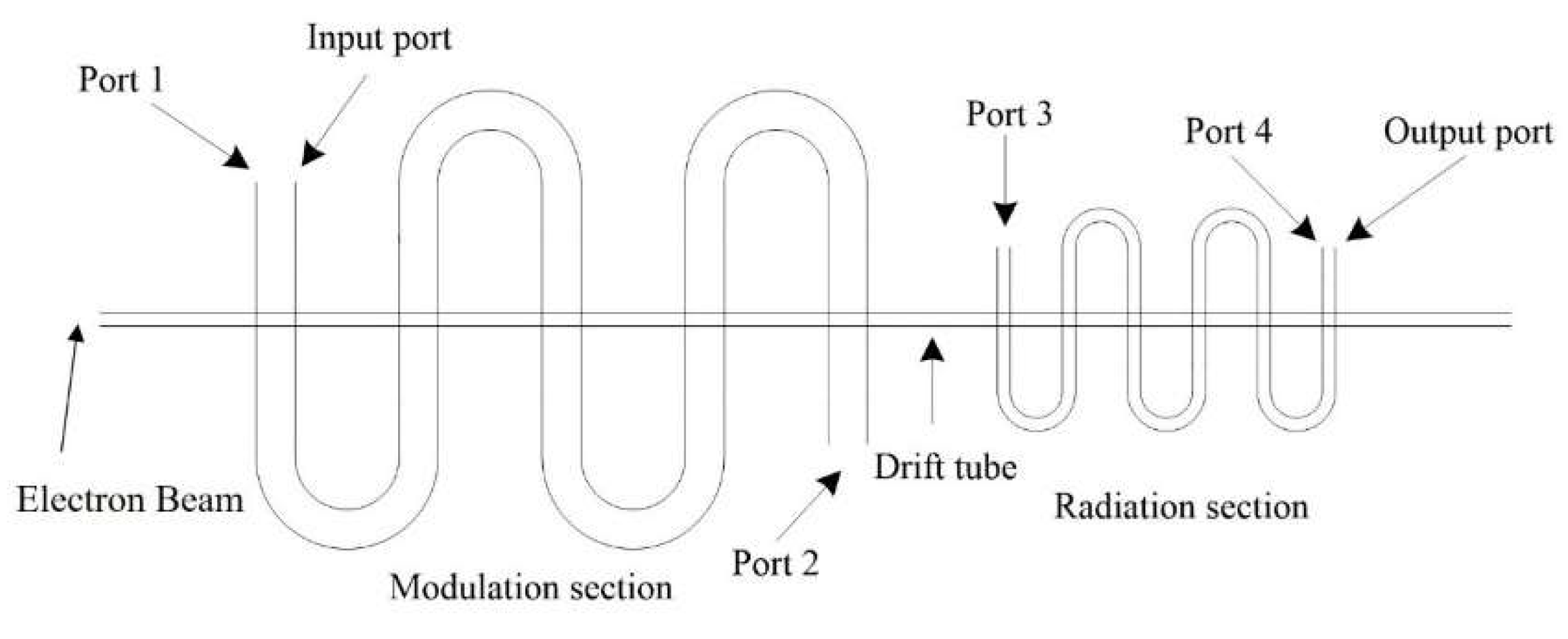
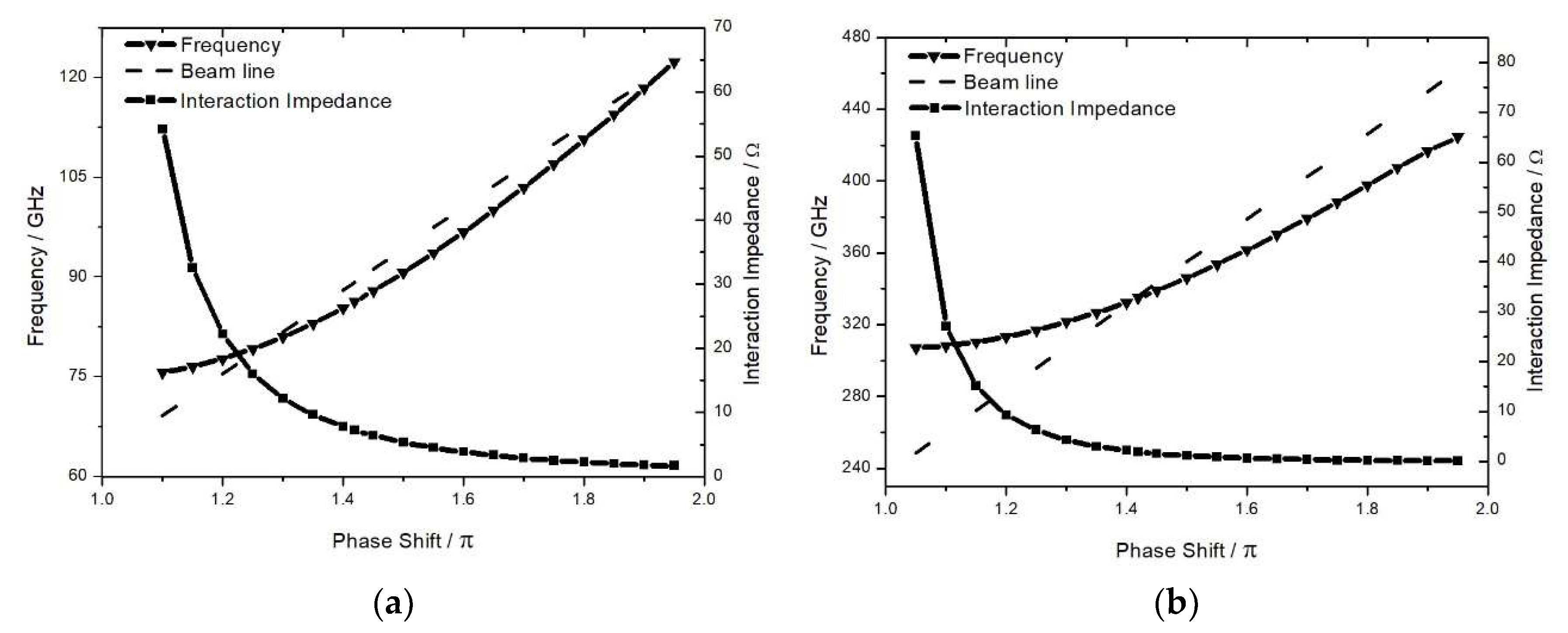
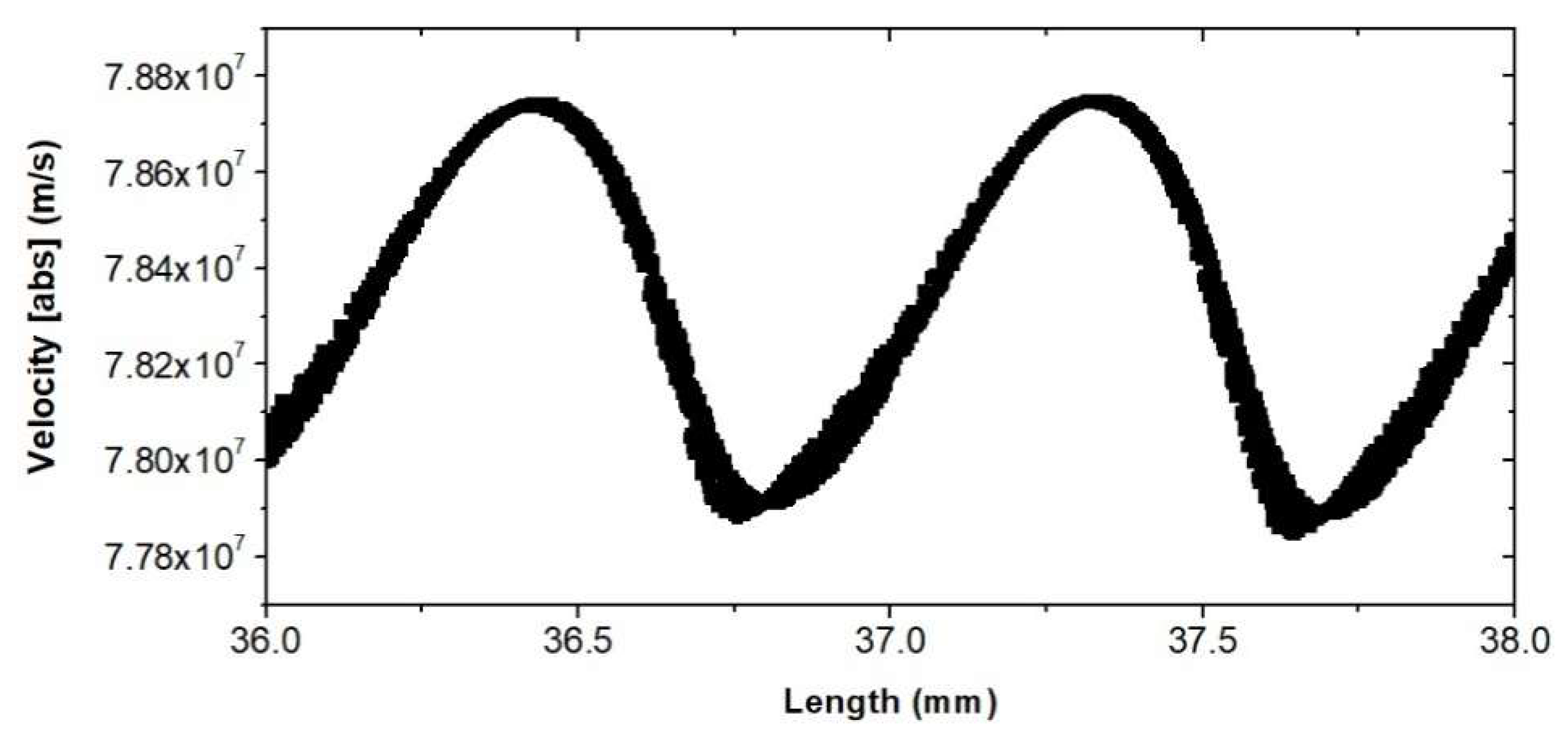
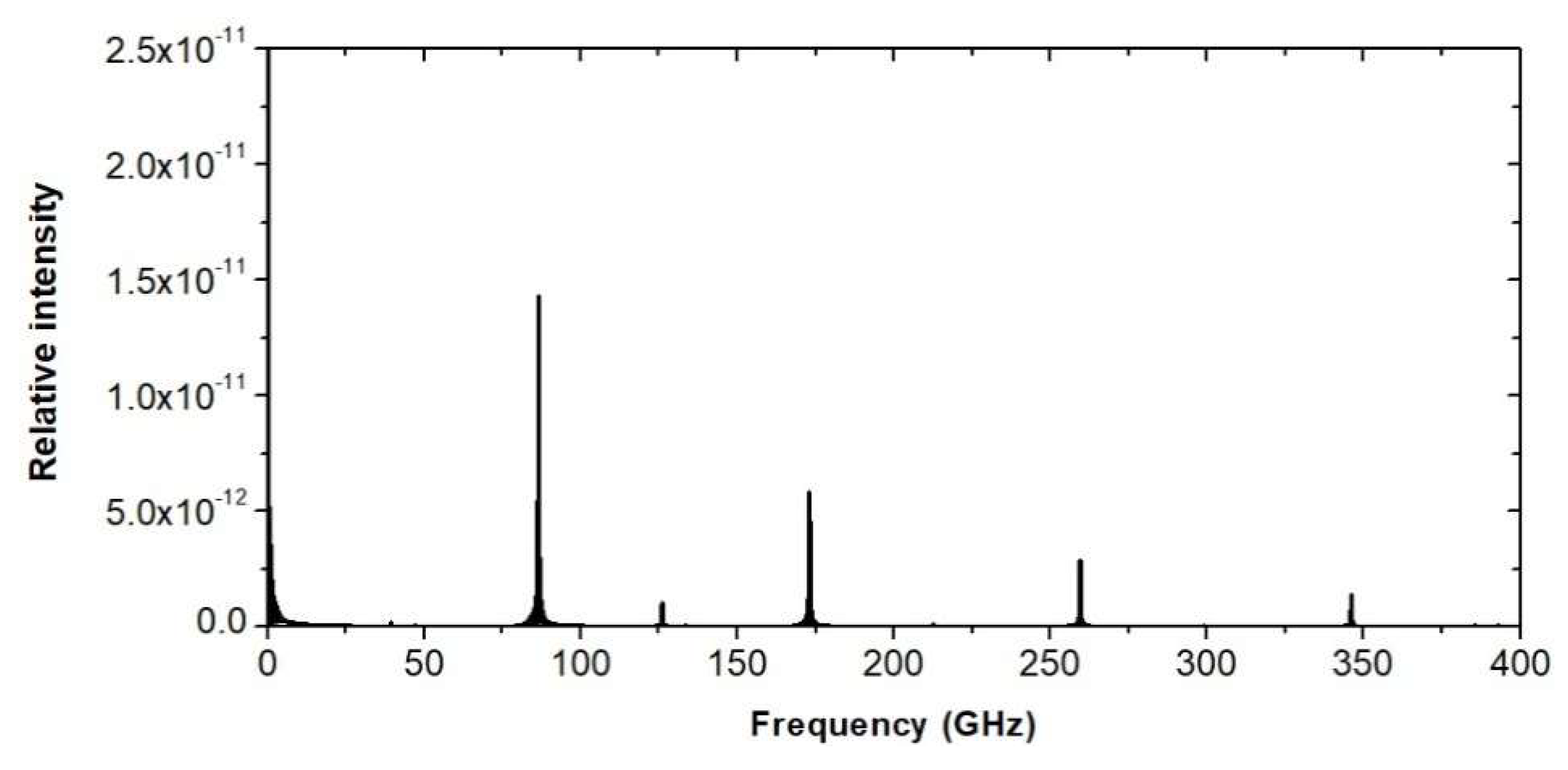

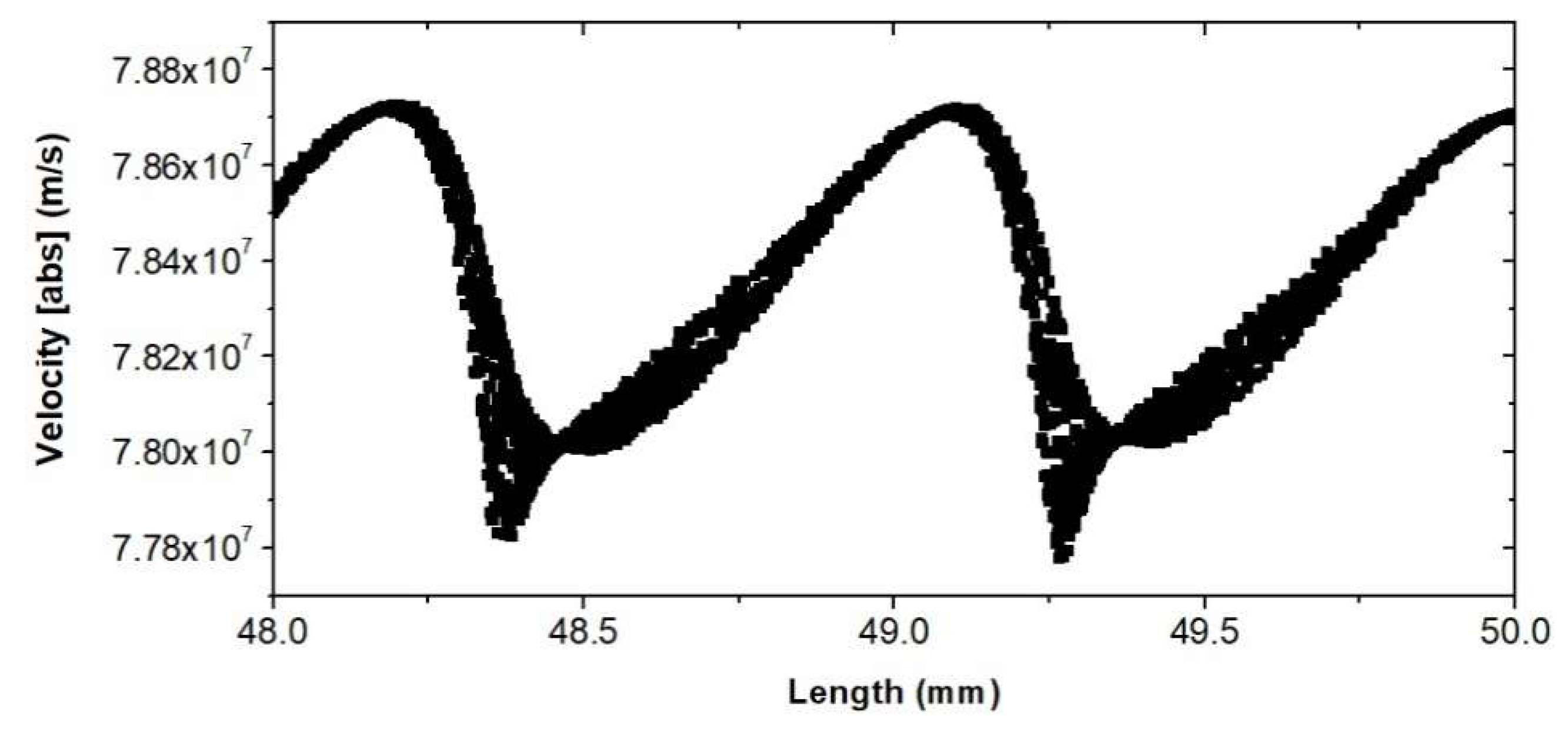
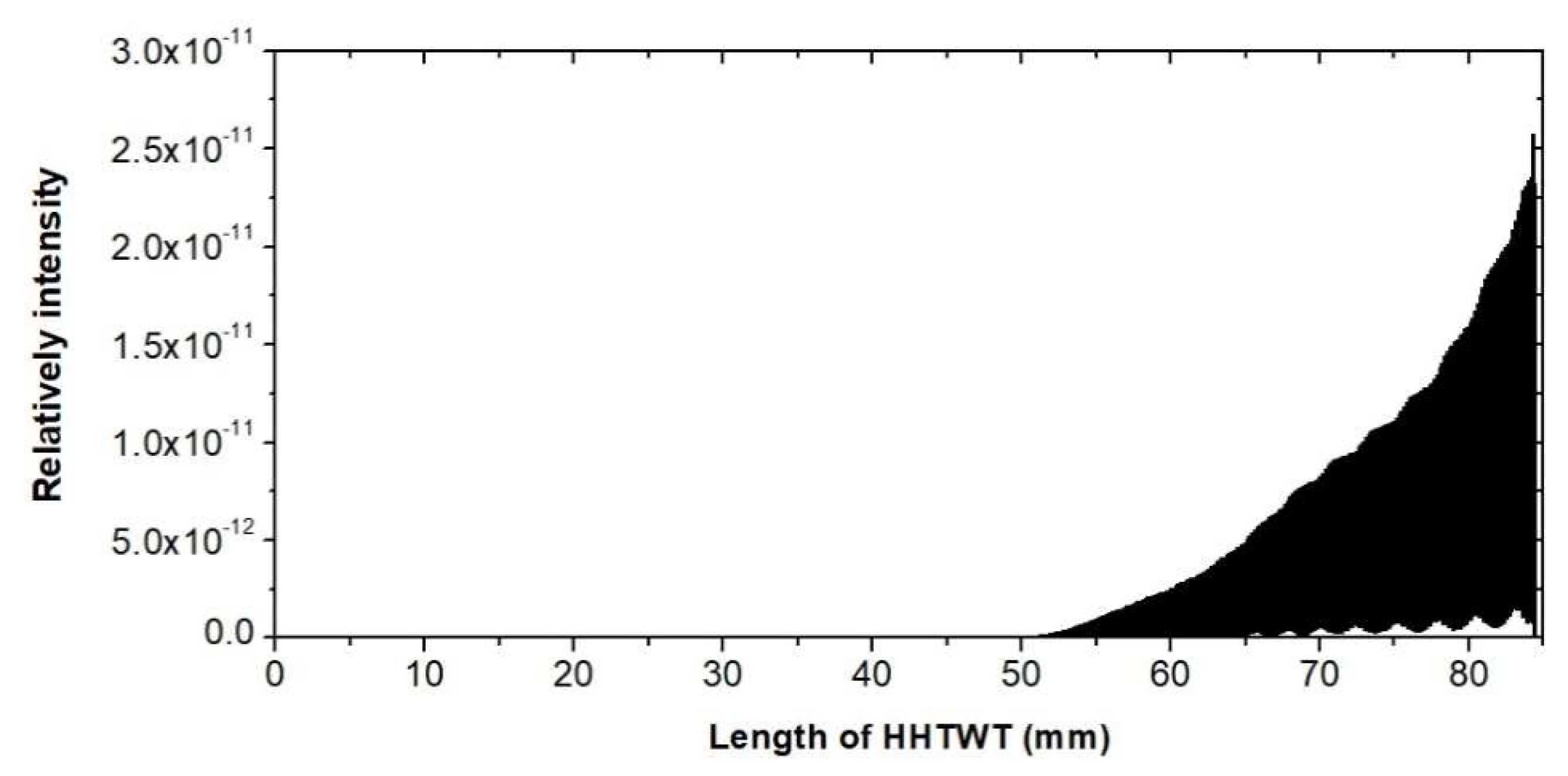
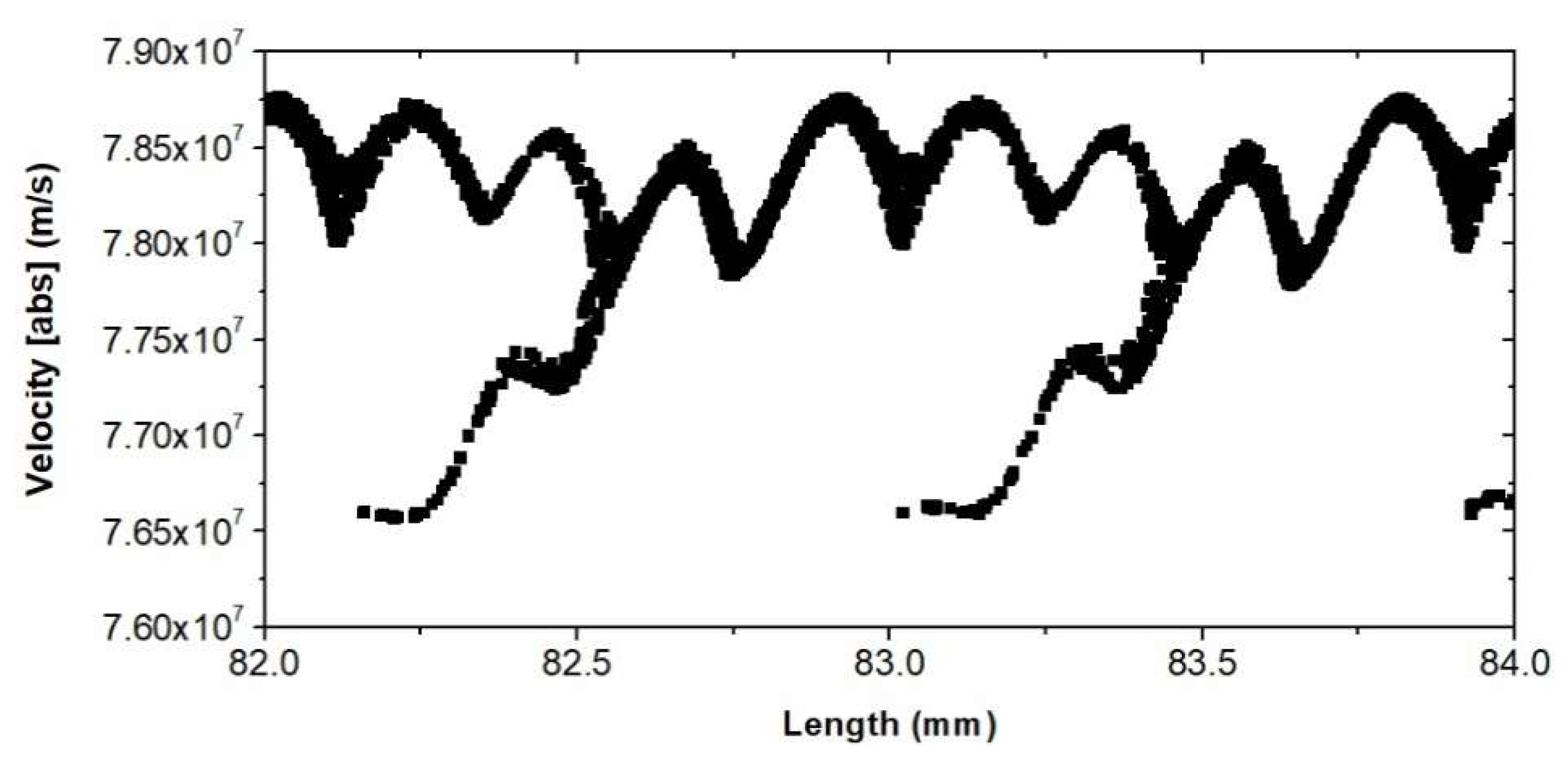


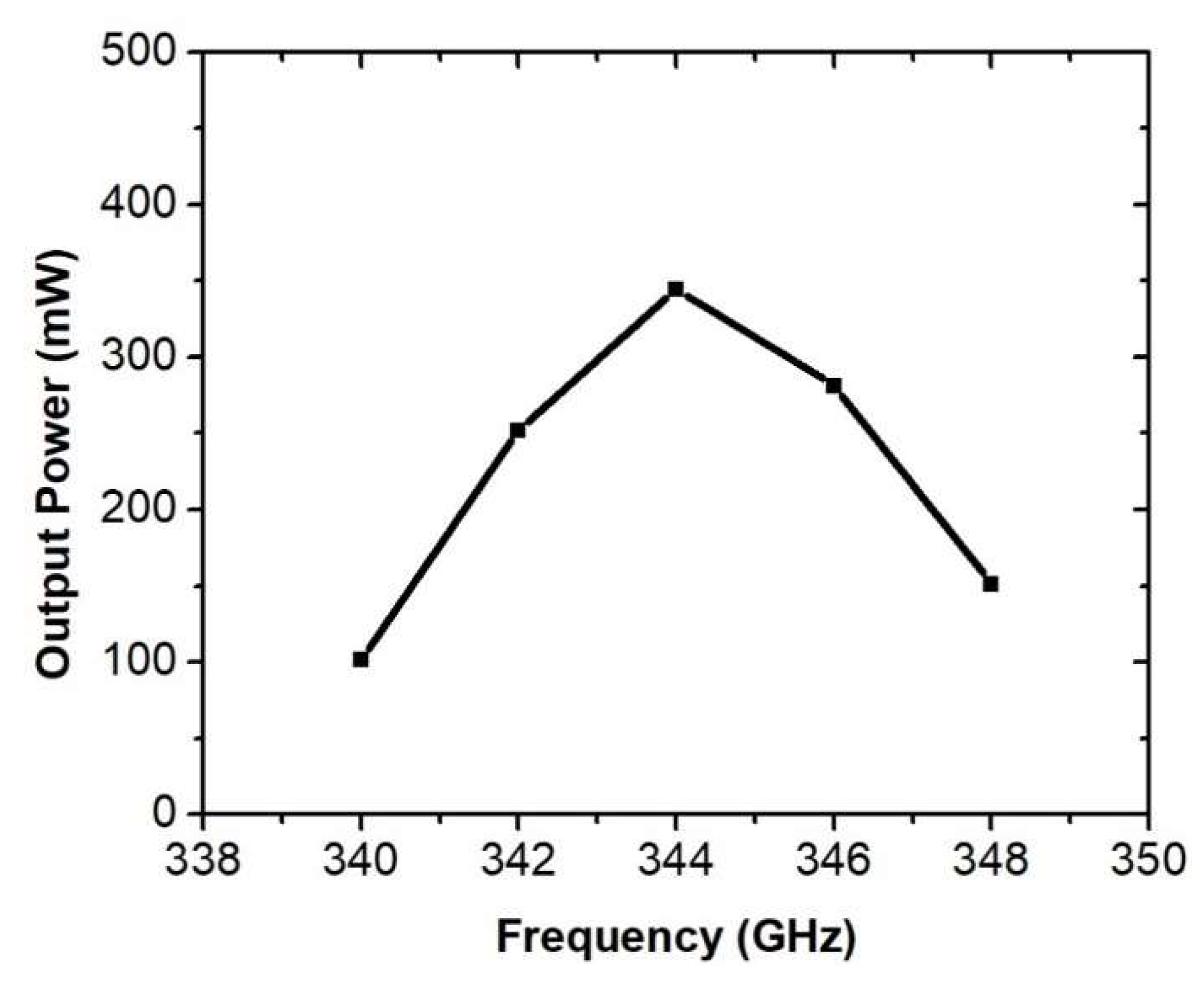


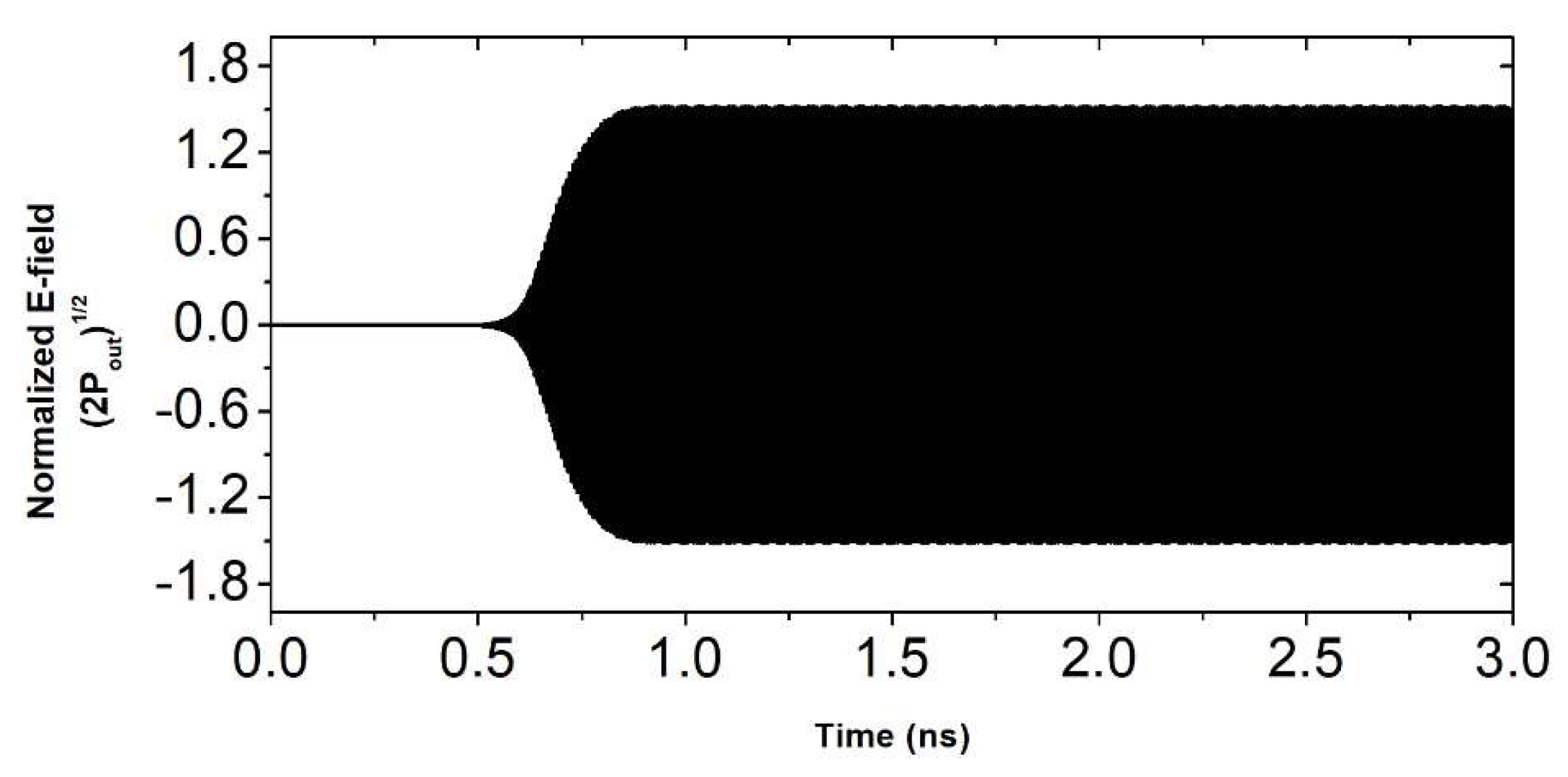
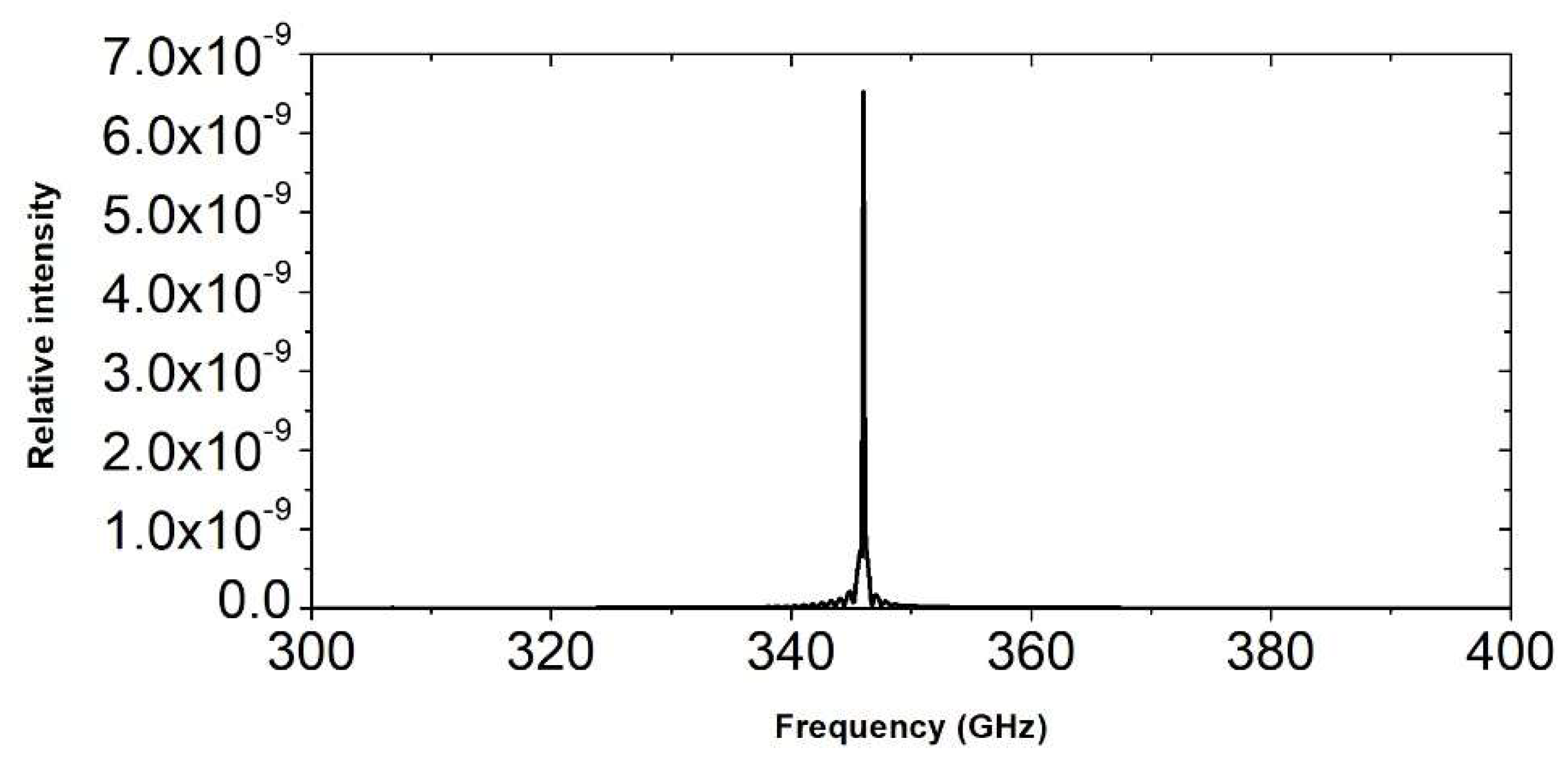
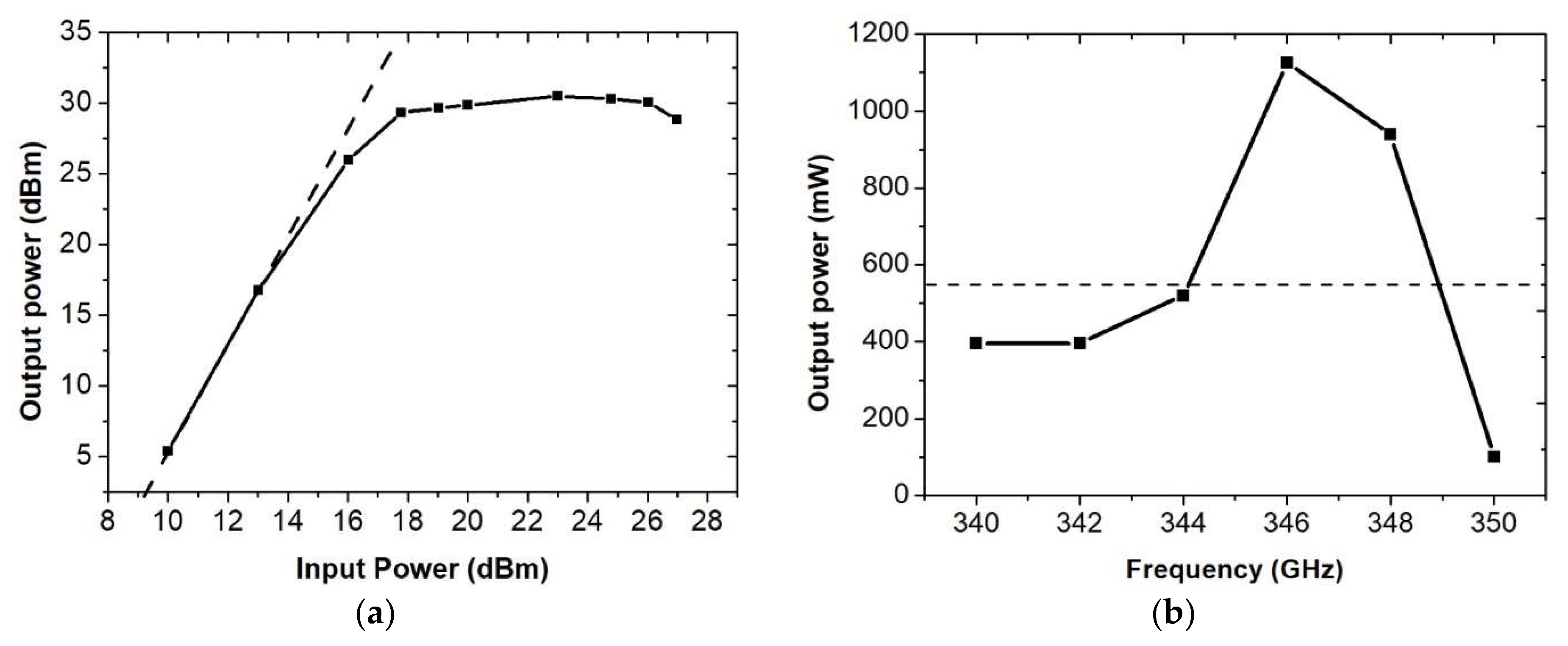




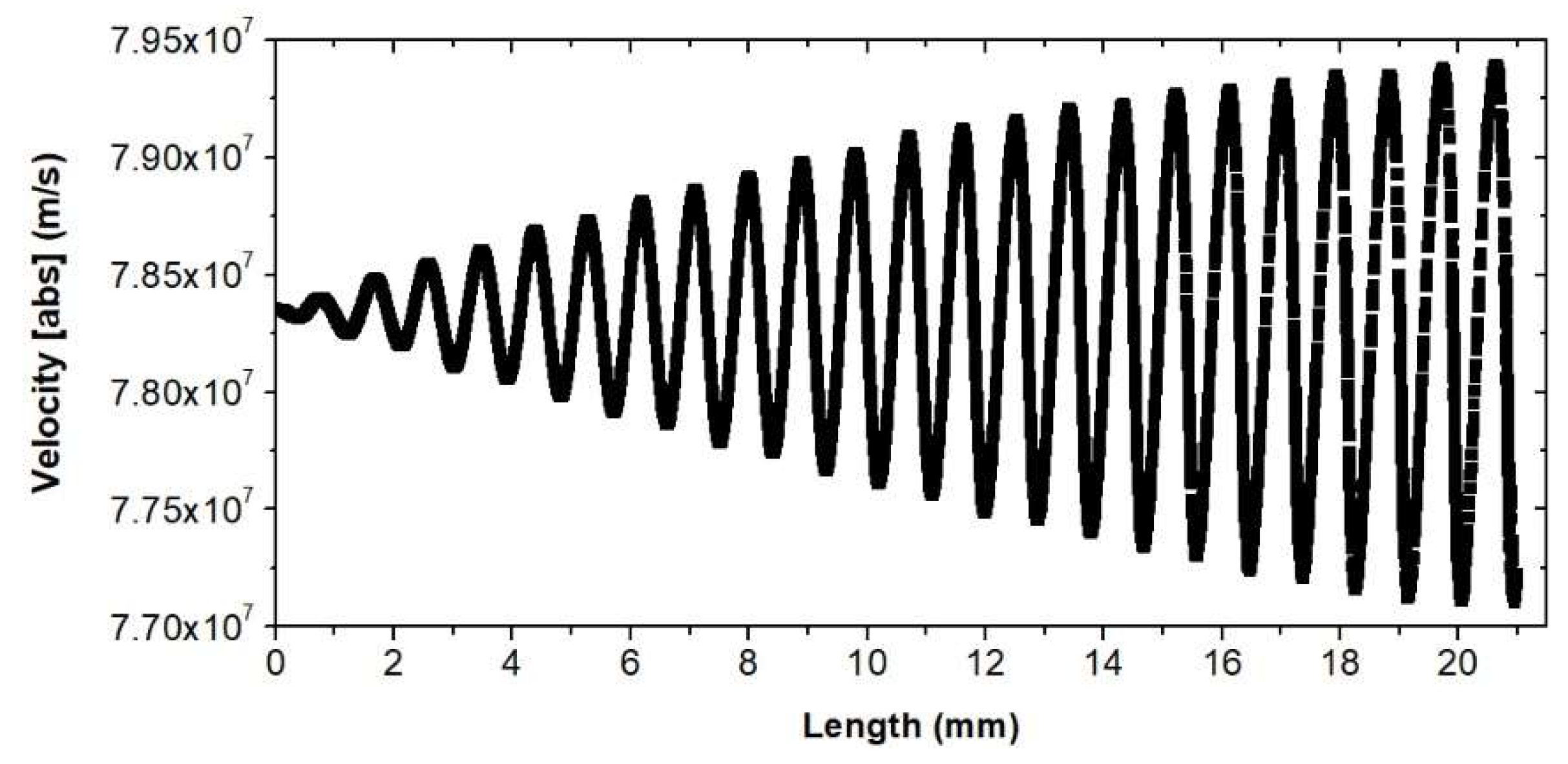
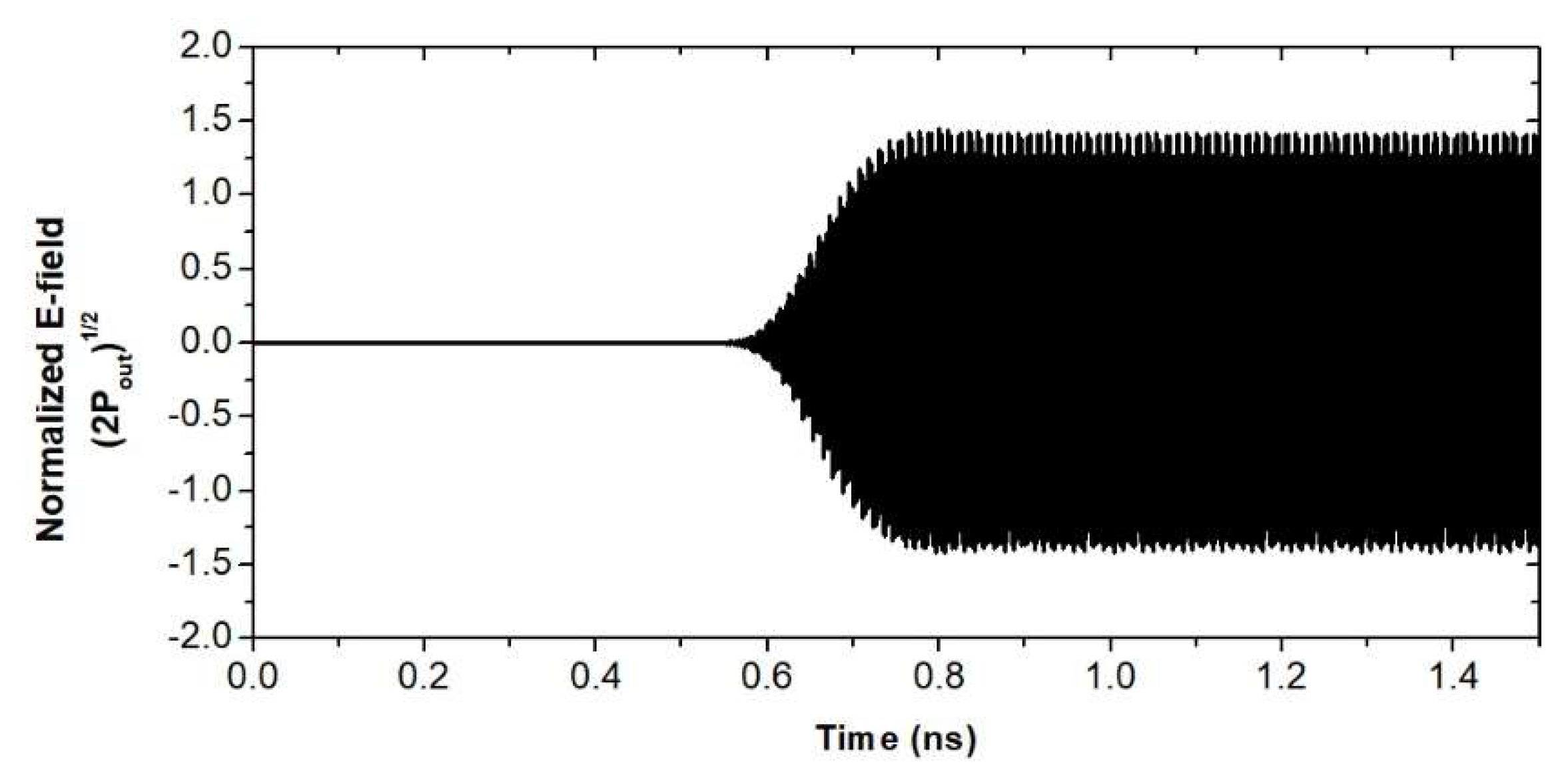

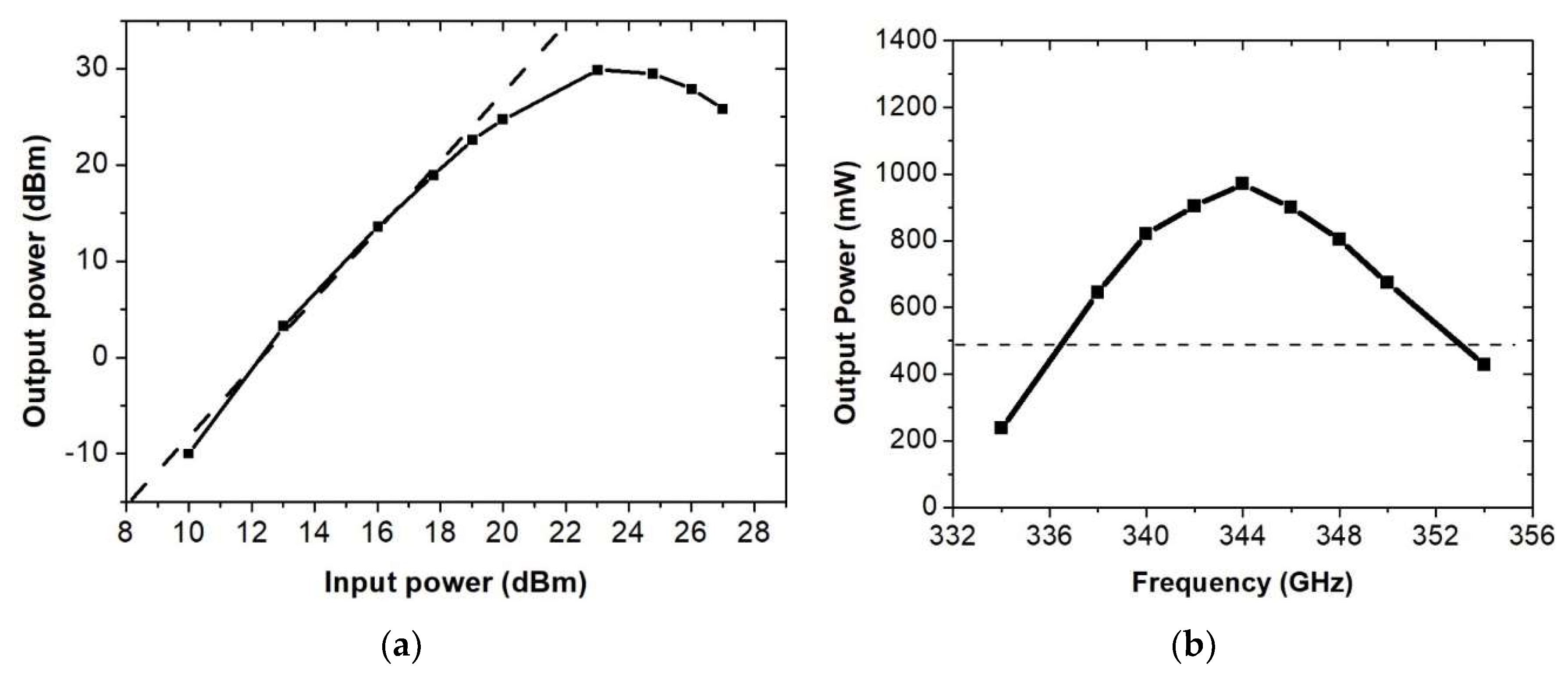
| Parameters | Modulation Section | Radiation Section | Drift Tube |
|---|---|---|---|
| a | 2 mm | 0.5 mm | / |
| b | 0.32 mm | 0.085 mm | / |
| p | 0.64 mm | 0.17 mm | / |
| h | 0.51 mm | 0.2 mm | / |
| r | 0.08 mm | 0.08 mm | 0.08 mm |
| Parameters | Values |
|---|---|
| Beam voltage | 18.4 kV |
| Beam current | 10 mA |
| Beam radius | 0.04 mm |
| Length of modulation section | 38 mm |
| Length of drift tube | 12 mm |
| Length of radiation section | 34 mm |
| Parameters | Values |
|---|---|
| Beam voltage of beam 1 and 2 | 18.4 kV |
| Beam current of beam 1 and 2 | 10 mA |
| Beam radius | 0.04 mm |
| Length of modulation section | 38 mm |
| Length of drift tube | 12 mm |
| Length of radiation section | 34 mm |
| Length of amplification section | 34 mm |
| Parameters | Values |
|---|---|
| Beam voltage of beam 1 and 2 | 18.4 kV |
| Beam current of beam 1 and 2 | 10 mA |
| Beam radius | 0.04 mm |
| Length of pre-amplification section | 51 mm |
| Length of modulation section | 20.5 mm |
| Length of drift tube | 4 mm |
| Length of radiation section | 10.2 mm |
Publisher’s Note: MDPI stays neutral with regard to jurisdictional claims in published maps and institutional affiliations. |
© 2021 by the authors. Licensee MDPI, Basel, Switzerland. This article is an open access article distributed under the terms and conditions of the Creative Commons Attribution (CC BY) license (http://creativecommons.org/licenses/by/4.0/).
Share and Cite
Zhang, R.; Wang, Q.; Deng, D.; Dong, Y.; Xiao, F.; Travish, G.; Gong, H. Novel Dual Beam Cascaded Schemes for 346 GHz Harmonic-Enhanced TWTs. Electronics 2021, 10, 195. https://doi.org/10.3390/electronics10020195
Zhang R, Wang Q, Deng D, Dong Y, Xiao F, Travish G, Gong H. Novel Dual Beam Cascaded Schemes for 346 GHz Harmonic-Enhanced TWTs. Electronics. 2021; 10(2):195. https://doi.org/10.3390/electronics10020195
Chicago/Turabian StyleZhang, Ruifeng, Qi Wang, Difu Deng, Yao Dong, Fei Xiao, Gil Travish, and Huarong Gong. 2021. "Novel Dual Beam Cascaded Schemes for 346 GHz Harmonic-Enhanced TWTs" Electronics 10, no. 2: 195. https://doi.org/10.3390/electronics10020195
APA StyleZhang, R., Wang, Q., Deng, D., Dong, Y., Xiao, F., Travish, G., & Gong, H. (2021). Novel Dual Beam Cascaded Schemes for 346 GHz Harmonic-Enhanced TWTs. Electronics, 10(2), 195. https://doi.org/10.3390/electronics10020195




